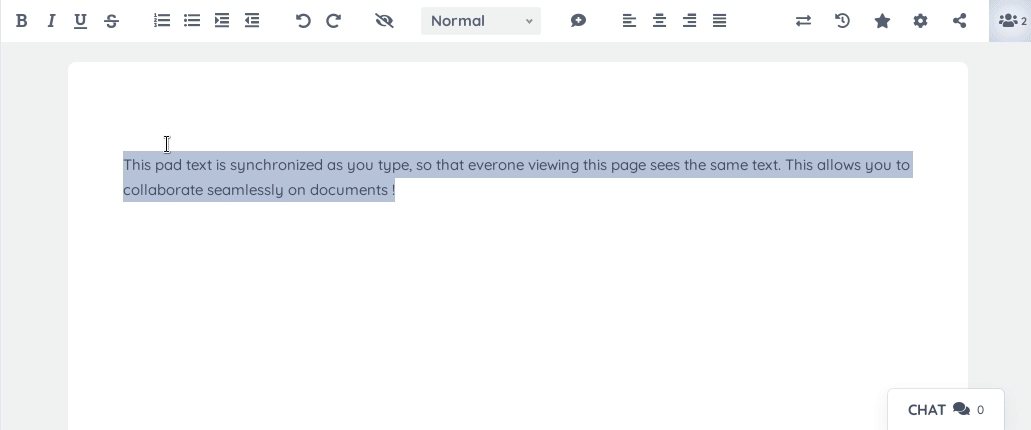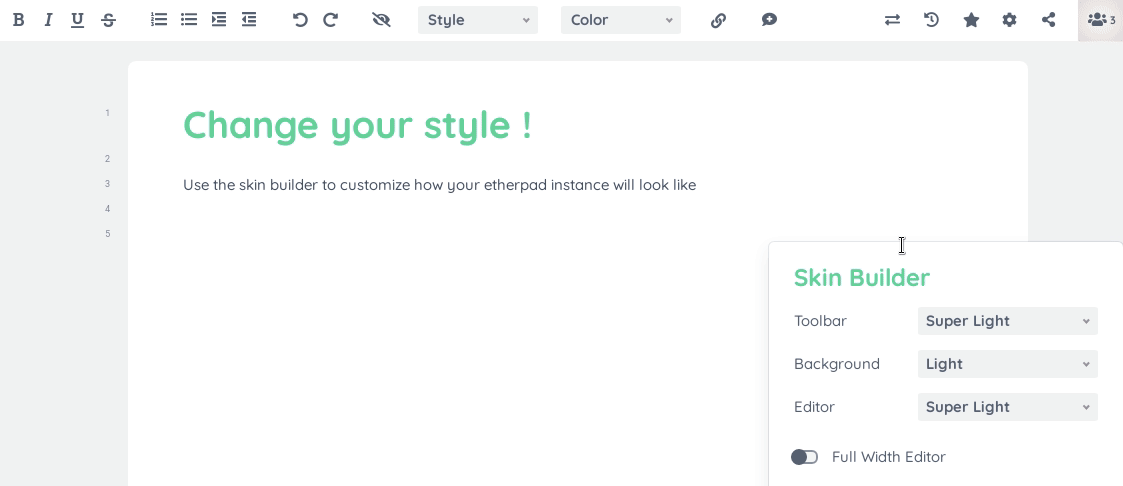12 KiB
Etherpad: A real-time collaborative editor for the web
About
Etherpad is a real-time collaborative editor scalable to thousands of simultaneous real time users. It provides full data export capabilities, and runs on your server, under your control.
Try it out
Wikimedia provide a public Etherpad instance for you to Try Etherpad out. or use another public Etherpad instance to see other features
Project Status
We're looking for maintainers and have some funding available. Please contact John McLear if you can help.
Code Quality
Testing
Engagement
Installation
Requirements
Node.js >= 14.0.0.
GNU/Linux and other UNIX-like systems
Quick install on Debian/Ubuntu
curl -sL https://deb.nodesource.com/setup_14.x | sudo -E bash -
sudo apt install -y nodejs
git clone --branch master https://github.com/ether/etherpad-lite.git &&
cd etherpad-lite &&
src/bin/run.sh
Manual install
You'll need Git and Node.js installed.
As any user (we recommend creating a separate user called etherpad):
- Move to a folder where you want to install Etherpad.
- Clone the Git repository:
git clone --branch master https://github.com/ether/etherpad-lite.git - Change into the new directory containing the cloned source code:
cd etherpad-lite - Run
src/bin/run.shand open http://127.0.0.1:9001 in your browser.
To update to the latest released version, execute git pull origin. The next
start with src/bin/run.sh will update the dependencies.
Windows
Prebuilt Windows package
This package runs on any Windows machine. You can perform a manual installation via git for development purposes, but as this uses symlinks which performs unreliably on Windows, please stick to the prebuilt package if possible.
- Download the latest Windows package
- Extract the folder
Run start.bat and open http://localhost:9001 in your browser.
Manually install on Windows
You'll need Node.js and (optionally, though recommended) git.
- Grab the source, either:
- download https://github.com/ether/etherpad-lite/zipball/master
- or
git clone --branch master https://github.com/ether/etherpad-lite.git
- With a "Run as administrator" command prompt execute
src\bin\installOnWindows.bat
Now, run start.bat and open http://localhost:9001 in your browser.
Update to the latest version with git pull origin, then run
src\bin\installOnWindows.bat, again.
If cloning to a subdirectory within another project, you may need to do the following:
- Start the server manually (e.g.
node src/node/server.js) - Edit the db
filenameinsettings.jsonto the relative directory with the file (e.g.application/lib/etherpad-lite/var/dirty.db) - Add auto-generated files to the main project
.gitignore
Docker container
Find here information on running Etherpad in a container.
Plugins
Etherpad is very customizable through plugins.
Available Plugins
For a list of available plugins, see the plugins site.
Plugin Installation
You can install plugins from the admin web interface (e.g., http://127.0.0.1:9001/admin/plugins).
Alternatively, you can install plugins from the command line:
cd /path/to/etherpad-lite
# The `--no-save` and `--legacy-peer-deps` arguments are necessary to work
# around npm quirks.
npm install --no-save --legacy-peer-deps ep_${plugin_name}
Also see the plugin wiki article.
Suggested Plugins
Run the following command in your Etherpad folder to get all of the features visible in the above demo gif:
npm install --no-save --legacy-peer-deps \
ep_align \
ep_comments_page \
ep_embedded_hyperlinks2 \
ep_font_color \
ep_headings2 \
ep_markdown \
ep_webrtc
For user authentication, you are encouraged to run an OpenID Connect identity provider (OP) and install the following plugins:
- ep_openid_connect to authenticate against your OP.
- ep_guest to create a "guest" account that has limited access (e.g., read-only access).
- ep_user_displayname to automatically populate each user's displayed name from your OP.
- ep_stable_authorid so that each user's chosen color, display name, comment ownership, etc. is strongly linked to their account.
Next Steps
Tweak the settings
You can modify the settings in settings.json. If you need to handle multiple
settings files, you can pass the path to a settings file to src/bin/run.sh
using the -s|--settings option: this allows you to run multiple Etherpad
instances from the same installation. Similarly, --credentials can be used to
give a settings override file, --apikey to give a different APIKEY.txt file
and --sessionkey to give a non-default SESSIONKEY.txt. Each configuration
parameter can also be set via an environment variable, using the syntax
"${ENV_VAR}" or "${ENV_VAR:default_value}". For details, refer to
settings.json.template. Once you have access to your /admin section,
settings can be modified through the web browser.
If you are planning to use Etherpad in a production environment, you should use
a dedicated database such as mysql, since the dirtyDB database driver is
only for testing and/or development purposes.
Secure your installation
If you have enabled authentication in users section in settings.json, it is
a good security practice to store hashes instead of plain text passwords in
that file. This is especially advised if you are running a production
installation.
Please install ep_hash_auth plugin
and configure it. If you prefer, ep_hash_auth also gives you the option of
storing the users in a custom directory in the file system, without having to
edit settings.json and restart Etherpad each time.
Customize the style with skin variants
Open http://127.0.0.1:9001/p/test#skinvariantsbuilder in your browser and start playing!
Helpful resources
The wiki is your one-stop resource for Tutorials and How-to's.
Documentation can be found in doc/.
Development
Things you should know
You can debug Etherpad using src/bin/debugRun.sh.
You can run Etherpad quickly launching src/bin/fastRun.sh. It's convenient for
developers and advanced users. Be aware that it will skip the dependencies
update, so remember to run src/bin/installDeps.sh after installing a new
dependency or upgrading version.
If you want to find out how Etherpad's Easysync works (the library that makes
it really realtime), start with this
PDF
(complex, but worth reading).
Contributing
Read our Developer Guidelines
HTTP API
Etherpad is designed to be easily embeddable and provides a HTTP API that allows your web application to manage pads, users and groups. It is recommended to use the available client implementations in order to interact with this API.
OpenAPI (previously swagger) definitions for the API are exposed under
/api/openapi.json.
jQuery plugin
There is a jQuery plugin that helps you to embed Pads into your website.
Plugin Framework
Etherpad offers a plugin framework, allowing you to easily add your own features. By default your Etherpad is extremely light-weight and it's up to you to customize your experience. Once you have Etherpad installed you should visit the plugin page and take control.
Translations / Localizations (i18n / l10n)
Etherpad comes with translations into all languages thanks to the team at TranslateWiki.
If you require translations in plugins please send pull request to each plugin individually.
FAQ
Visit the FAQ.
Get in touch
The official channel for contacting the development team is via the GitHub issues.
For responsible disclosure of vulnerabilities, please write a mail to the maintainers (a.mux@inwind.it and contact@etherpad.org).
Join the official Etherpad Discord Channel.








